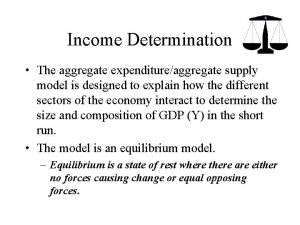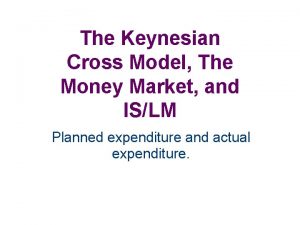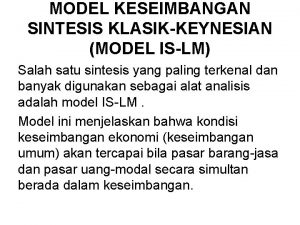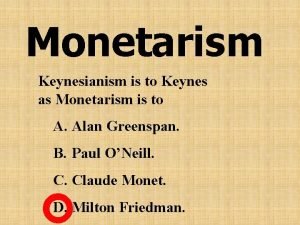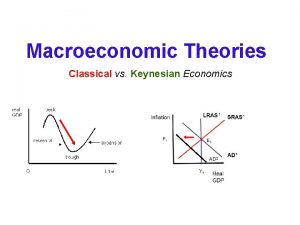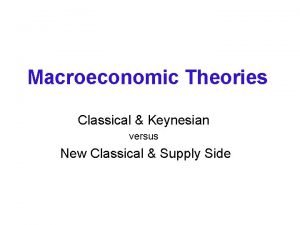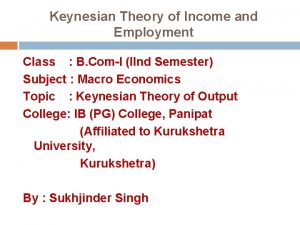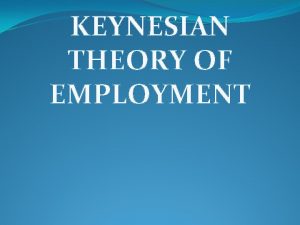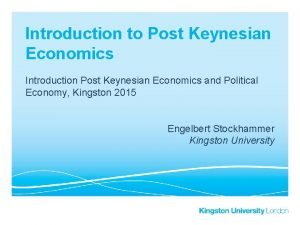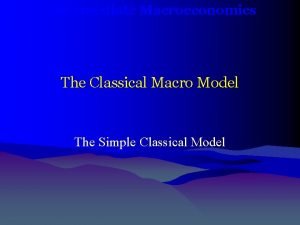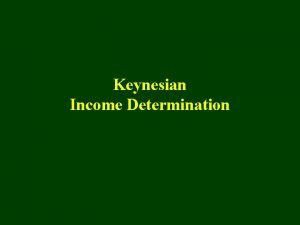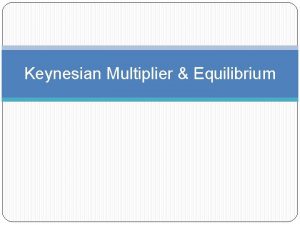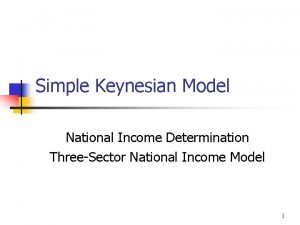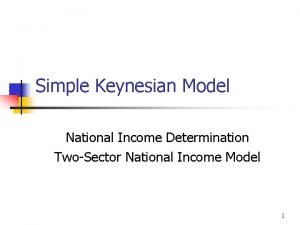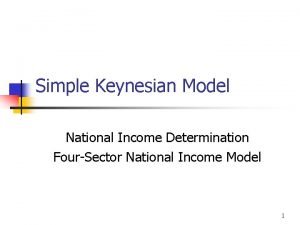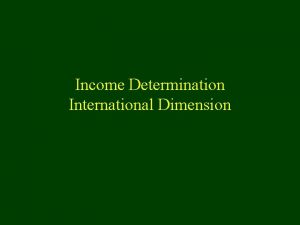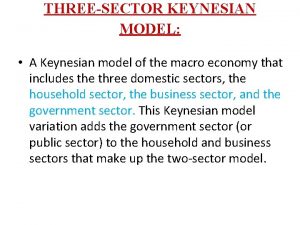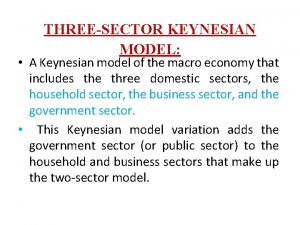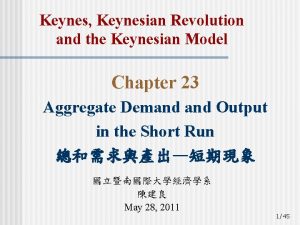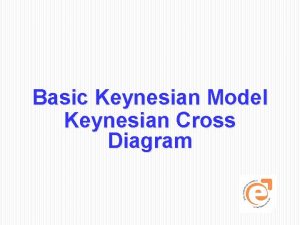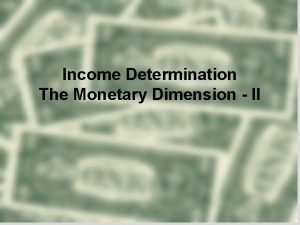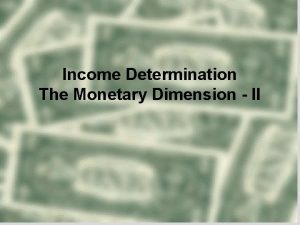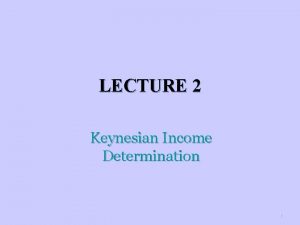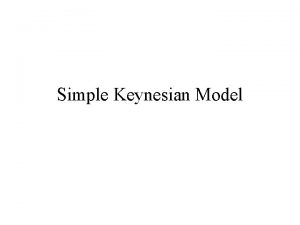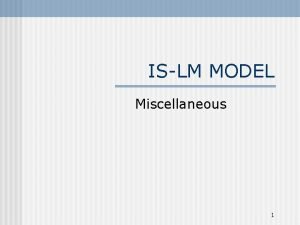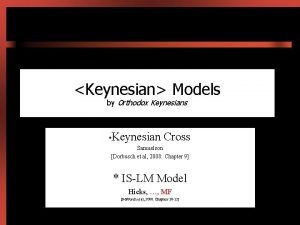Simple Keynesian Model Of Income Determination During 1930





















- Slides: 21

Simple Keynesian Model Of Income Determination • During 1930 s a serious and deep rooted depression occurred. • During this depression a steep decline in economic activities was experienced. • Unemployment in U. S rose from 3. 2 per cent in 1929 to 25. 2 per cent in 1933. The GNP fell by 30 per cent and could not be recovered until 1939. • In U. K. also the level of unemployment remained around 11 per cent throughout the decade of depression. • This gave rise to a debate amongst the economists.

Simple Keynesian Model (closed) • The debate was over the causes of unemployment and policy prescription and its response. • British economist J. M. Keynes developed his revolutionary theory of macroeconomics. • His macroeconomics was published in the form of a book in 1936, entitled, ‘The General Theory of Employment, Interest and Money’. • This book became the foundation of what is later known as Keynesian Economics.

Simple Keynesian Model ( closed) • Keynes pointed out that deficiency in aggregate demand was the cause for high unemployment and falling GNP. • According to him fiscal and monetary policies should be so designed as to increase the aggregate demand. • The government should spend more on public works during depression.

Simple Keynesian Model (closed) • Keynes contradicting the views of classical model • He explained that equilibrium level of output in the economy may not necessarily be at full employment, it can be at less than full employment, at full employment or at overfull employment. • According to him equilibrium level of output is one where aggregate demand (AD) is equal to aggregate supply or output (Y) irrespective of the level of employment associated with it. • Y = AD • In the simple Keynesian model that output follows aggregate demand which is contrary to Say’s Law of market that ‘supply creates its own demand’. • Keynes entire emphasis was on increasing the aggregate demand.

Simple Keynesian Model(closed) • Main Assumptions: • (i) There exists deficiency of aggregate demand causing involuntary unemployment. At the prevailing wage rate workers are willing to work but they do not find jobs. • (ii) Perfect competition exists in both factor markets as well as in product markets. • (iii) Only short run behavior of macro variables has been studied. Population and technology have been assumed to remain constant.

Simple Keynesian Model(closed) • Components of Aggregate Demand: • Keynes emphasized that it was AD which brings changes in the equilibrium level of income and employment. • AD comes out of total spending comprising of • consumption spending • domestic private business-investment spending and • government spending on the purchase of goods and services, in a closed economy. • In case of an open economy we may add net spending on exports and imports to the aggregate demand. • These different spending have been called as the components of aggregate demand. A brief study of these components is necessary to understand how changes in AD can be brought about.

Simple Keynesian Model(closed) • Consumption Expenditure: • Consumption expenditure constitutes more than 62 per cent of GNP in any economy, hence is the most important component of AD. Keynes believed that purchases of consumer goods and services depend on current income of the households. • But current income has been considered by Keynes as the primary factor to influence consumption expenditure. • The relation of consumption expenditure to income is known as consumption function.

Simple Keynesian Model (closed) • Consumption Function: • Consumption f unction has been considered as the most notable contribution of Keynes to economic theory. • According to him demand for consumer goods depends upon current disposable income. Every rise or fall in the later leads to direct rise or fall in consumption expenditure. This direct relationship between the two has been termed as consumption function. • This can be written as: • C = ƒ(Yd) or C = ƒ(Y – T) …(1) • where Yd stands for disposable income • T for lump sum tax

Simple Keynesian Model(closed) • According to Keynes, consumption is a linear function of disposable income, i. e. , a relationship between the two can be shown by a straight line and an equation given below: • C = a 0 + b. Yd; a 0 > 0 1 > b > 0 …(2) This consumption income relationship as shown by Equation (2) has been graphed in Fig. 1. where a 0 is a positive intercept showing some positive consumption expenditure even at zero level of income. This is called subsistence consumption. • The parameter b shows the slope of the consumption function, i. e. , the change in consumption expenditure per unit change in disposable income as shown in Fig. 1. consumption ( C ) C= a 0 + b. Yd; Fig. 1 Income (Y)

Simple Keynesian Model(closed) • Derivation of Saving Function • Total disposable income of individual is divided into consumption and saving • Y=C+S • C = a 0 + b. Yd • S=Yd- C= Yd - a 0 – b. Yd = - a 0 + (1 – b ) Yd Saving • Fig. 2 o - a 0 S=- a 0 + (1 – b ) Yd Y(income)

Simple Keynesian Model(closed) • Keynes termed this slope relationship as marginal propensity to consume (MPC) and marginal propensity to save ( MPS). • Keynes believed that consumption will increase with every increase in disposable income but less than the increase in disposable income as Yd =C+S • C = a 0 + b. Yd, C/ / Yd = change in consumption due to change in income = b (MPC) • (0 < b < 1). • In the short run MPC remains stable and constant at every level of income. From the consumption functions shown above we can find the level of consumption expenditure MPC at any level of income a 0 shows the amount of consumption expenditure even at zero level of income, which comes out of past savings (-a 0). At Y 0 entire consumption is financed out of current income.

Simple Keynesian Model(closed) • Marginal Propensity to Save: • Increment in income leads to increase in saving is also a function of income. • We know that national income can be stated: • Y=C+S+T • We know that Yd = Y – T = C + S • Thus in the Keynesian model a saving income relationship can be established by the equation given below and in. Fig. 2. S=Yd- C= Yd - a 0 – b. Yd = - a 0 + (1 – b ) Yd S/ Yd = (1 -b)= MPS

Simple Keynesian Model(closed) • Component of AD • Investment: • In Keynesian model investment is crucially important component of aggregate demand. It is a key factor to change the aggregate demand hence income. • Investment here means private business investment only. We can define investment as change in existing capital stock, i. e. , capital formation. • In SKM, Keynes invented that investment is an autonomous expenditure determined independent of the level of income.

Simple Keynesian Model(closed) • Government Expenditure: • Government expenditure is a third major component of AD. • In SKM, by assumption government expenditure is exogenously given and also known as autonomous expenditure • It is autonomous because it is primarily determined by policymakers and not by income, hence, is also an exogenous variable. • Tax rates are also determined by policy makers. This is also exogenously given.

Simple Keynesian Model(closed) • In SKM all the variables of aggregate demand are planned variables. • These variables are expressed in terms of Ex-ante magnitude. • Thus planned AD in model comprises of planned consumption planned investment and planned Govt. expenditure. • These variables are determined by decisions taken by different economic units. • Ex-post concept refers to actual magnitude.

Simple Keynesian Model(closed) • Determination of Equilibrium Level of Income: • In Keynesian model equilibrium level of income or output is one where actual total output (Ex-post)is equal to planned aggregate demand (expenditure) • It can be expressed by the equation: • Y = AD • The proceeding section shows that the components of aggregate demand are consumption expenditure (C), Intended investment expenditure (i) and the government expenditure on the purchase of goods and services (G). • At equilibrium level of output, therefore condition (i) can be written as: • Y = AD = C + I + G

Simple Keynesian Model(closed) • Since Y is total output consisting of consumption goods (C), investment goods like machinery, tools and plants etc. also known as real investment (Ir) and the goods and services for government purchase (G), it can he expressed as: • Y = C + I r+ G • Combining equations (i) and (ii) • C + I r+ G = C + I + G • Cancelling C and G from both sides we have • Ir=I • meaning thereby, equilibrium level of output which is an endogenous variable can take place only at a level where intended investment (I) is equal to real investment (Ir).

Simple Keynesian model (closed) • If (I), intended investment(Ex-ante) is greater than Ir, real investment (Ex-post) (I > Ir) then AD would be greater than AS or total output. • The producers will meet this extra demand by declining their inventories (extra amount of production) which they maintain of a size considered ideal. This fall in their inventory size will induce them to produce more and, hence, output and employment will rise. Contrary to it, if I < Ir the size of their inventories will expand the producers will cut their production level. • Therefore, equilibrium level of output can be one where intended investment is equal to real investment.

Simple Keynesian model (closed) • Another condition for equilibrium relates to leakages (S + T) and injections (I + G) shown in the circular flow of income. Equilibrium level of output (or a constant flow of income) is possible only if leakages are equal to injections. • Hence, this condition can be expressed as: • S + T = I+ G • If the two sides are not equal a change in output is bound to occur. • So there can be three condition for equilibrium level of income: • Y = AD = C + I+ G …… (i) • Ir = I……. (ii) • S + T = I + G …. . (iii)

Simple Keynesian model (closed) Determination of equilibrium level of income satisfying above conditions can be shown with the help of following figure. .

Simple Keynesian model (closed) • The income level (Yd) is being measured along horizontal axis and the aggregate demand, along with its components, are being measured along vertical axis. • Every point of 45° line shows equal distance from both vertical and horizontal axis. Autonomous expenditure like investment and government expenditure do not depend on income, at least directly. The C + I + G schedule, therefore, lies above the consumption function by a constant amount. The fact that (I + G) does not depend on income is also reflected by the I + G line being horizontal to X-axis. Saving plus taxes (S+T) line slopes upward because saving and taxes vary positively with income. • Equilibrium level of income takes place at Y where the aggregate demand curve (C + I+ G) intersects the line of 45 o. Here (S + T) is equal to (I + G). At point Y aggregate demand (C + I + G) is also equal to output (Y) showing equilibrium level of income.
 S+t=i+g
S+t=i+g Keynesian model
Keynesian model Keynesian model
Keynesian model Keynesian cross model
Keynesian cross model Model islm
Model islm National income formula
National income formula Ttd and dtd
Ttd and dtd Comprehensive income reports an expanded version
Comprehensive income reports an expanded version Deferred tax asset journal entry
Deferred tax asset journal entry Samir fuddy
Samir fuddy Keynesian vs supply side
Keynesian vs supply side Monetarist vs keynesian vs classical
Monetarist vs keynesian vs classical Monetarism vs keynesianism
Monetarism vs keynesianism Keynesian vs classical
Keynesian vs classical Classical economics vs keynesian
Classical economics vs keynesian Keynesian vs classical vs monetarist
Keynesian vs classical vs monetarist Explain the keynesian theory of employment
Explain the keynesian theory of employment Classical theory vs keynesian theory
Classical theory vs keynesian theory Classical economics vs keynesian
Classical economics vs keynesian Keynesian consumption function
Keynesian consumption function Keynesian economics policy
Keynesian economics policy Keynesian vs classical vs monetarist
Keynesian vs classical vs monetarist
